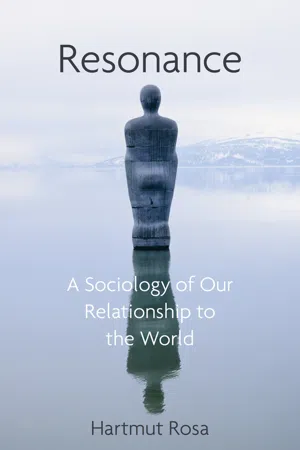
- English
- ePUB (mobile friendly)
- Available on iOS & Android
About This Book
The pace of modern life is undoubtedly speeding up, yet this acceleration does not seem to have made us any happier or more content. If acceleration is the problem, then the solution, argues Hartmut Rosa in this major new work, lies in "resonance." The quality of a human life cannot be measured simply in terms of resources, options, and moments of happiness; instead, we must consider our relationship to, or resonance with, the world.
Applying his theory of resonance to many domains of human activity, Rosa describes the full spectrum of ways in which we establish our relationship to the world, from the act of breathing to the adoption of culturally distinct worldviews. He then turns to the realms of concrete experience and action – family and politics, work and sports, religion and art – in which we as late modern subjects seek out resonance. This task is proving ever more difficult as modernity's logic of escalation is both cause and consequence of a distorted relationship to the world, at individual and collective levels. As Rosa shows, all the great crises of modern society – the environmental crisis, the crisis of democracy, the psychological crisis – can also be understood and analyzed in terms of resonance and our broken relationship to the world around us.
Building on his now classic work on acceleration, Rosa's new book is a major new contribution to the theory of modernity, showing how our problematic relation to the world is at the crux of some of the most pressing issues we face today. This bold renewal of critical theory for our times will be of great interest to students and scholars across the social sciences and humanities.
Frequently asked questions
Information
PART ONE
The Basic Elements of Human Relationships to the World
II
Bodily Relationships to the World
1 Being Situated in the World
In the beginning, […] humans are surrounded by something that can never appear as a thing. They are initially the invisibly augmented, the corresponding, the encompassed […]. My existence includes the presence of a pre-objective something floating around me; its purpose is to let me be and support me. Hence I am not, as current systemists and bio-ideologues claim I think, a living being in its environment; I am a floating being with whom geniuses forms spaces. “If anyone knew how marrowy I am at bottom.”5
First of all one must conceive of a phase of fetal cohabitation in which the incipient child experiences the sensory presence of liquids, soft bodies and cave boundaries: most importantly placental blood, then the amniotic fluid, the placenta, the umbilical cord, the amniotic sac and a vague prefiguring of the experience of spatial boundaries through the resistance of the abdominal wall and elastic walling-in. A foretaste of what will later be called reality presents itself in the form of an intermediate fluidal realm that lies embedded in a dark, spheric spatial factor softly cushioned within further boundaries. […] Objects that, like those we have named, are not objects because they have no subject-like counterpart, are referred to by Macho as “nobjects”: they are spherically surrounding mini-conditions envisaged by a non-facing self, namely the fetal pre-subject, in the mode of a non-confrontational presence as original creatures of closeness in the literal sense. […] Consequently one must assume, as the most original of the pre-oral regimes, a suspended stage whose essential content lies in the constant placenta-mediated exchange of blood between mother and child. […] In reality, the fetal modus vivendi can be described as a fluidal communion in the medium of blood: it is the first material between two individuals who will one day – when they become modern people – speak on the telephone. […] The second aspect of the pre-oral media field concerns the psychoacoustic initiation of the fetus into the uterine sound world. It is logical that acoustic events can only be given in the nobject mode – for sonorous presences have no tangible substrate that could be encountered in the attitude of standing opposite something. From the physiology of listening as a state of being set in sympathetic vibration, it is evident that acoustic experiences are media processes which cannot possibly be represented in languages of object relationships.8
Table of contents
- Cover
- Table of Contents
- Title Page
- Copyright
- Acknowledgments
- In Lieu of a Foreword: Sociology and the Story of Anna and Hannah
- I Introduction
- Part One: The Basic Elements of Human Relationships to the World
- Part Two: Spheres and Axes of Resonance
- Part Three: Fear of the Muting of the World: A Reconstruction of Modernity in Terms of Resonance Theory
- Part Four: A Critical Theory of Our Relationship to the World
- In Lieu of an Afterword: Defending Resonance Theory against Its Critics – and Optimism against Skeptics
- References
- Index
- End User License Agreement